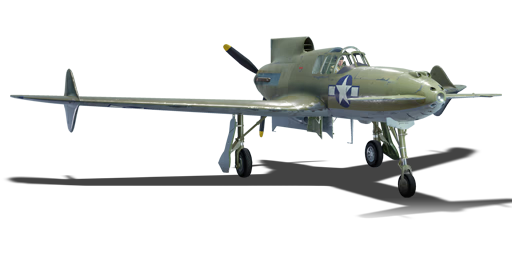



Researching new designs for better fighter and interceptor performances, the United States encouraged companies to develop radical new designs away from conventional fighter aircraft. Among the different designs submitted, Curtis-Wright's CW-24B design won out and their aircraft became designated as the XP-55 Ascender. With its front horizontal stabilizer (canard) contributing significantly to lift, it effectively acts as part of the wing, allowing the main wing area to be reduced, and also reducing the aircraft's drag. Three prototypes were created, but the flight characteristics were deemed not sufficient enough upgrade compared to conventional designs, and incoming jet age caused the US to refocus priority into new jet designs, leading to the cancellation of the XP-55.
Introduced in Update 1.31, the XP-55 Ascender is unlike anything most players would see in the U.S. tech tree. Flying this aircraft effectively requires a dedication to Energy Fighting. The XP-55 excels significantly in the ability to climb and dive, and this is your most significant advantage. The Ascender has decent manoeuvrability and best used in a Boom & Zoom function. All four of this aircraft's armament are packed tightly in the nose for devastating results.
flaps
flaps
flaps
brake
| Belt | Belt filling | Armor penetration (mm) at a distance: | |||||
|---|---|---|---|---|---|---|---|
| 10 m | 100 m | 500 m | 1000 m | 1500 m | 2000 m | ||
| HEF-I/AP-T | 39 | 36 | 25 | 16 | 10 | 6 | |
| AP-T/AP-T/HEF-I/HEF-I | 39 | 36 | 25 | 16 | 10 | 6 | |
| HEF-I/HEF-I/HEF-I/AP-T | 39 | 36 | 25 | 16 | 10 | 6 | |
| AP-T/AP-T/AP-T/HEF-I | 39 | 36 | 25 | 16 | 10 | 6 | |
| HEF-I | 5 | 4 | 3 | 3 | 3 | 3 | |
| Belt | Belt filling | Armor penetration (mm) at a distance: | |||||
|---|---|---|---|---|---|---|---|
| 10 m | 100 m | 500 m | 1000 m | 1500 m | 2000 m | ||
| T/Ball/Ball/I/AP-I | 28 | 26 | 18 | 11 | 7 | 4 | |
| AP-I/AP-I/AP-I/T/I | 28 | 26 | 18 | 11 | 7 | 4 | |
| T/AP/AP/AP/AP-I/I | 30 | 27 | 20 | 13 | 9 | 6 | |
| T/T/T/T/T/AP-I | 28 | 26 | 18 | 11 | 7 | 4 | |
| AP/AP-I/AP-I/I/I | 30 | 27 | 20 | 13 | 9 | 6 | |







 2 x (55 / 145 / 280) %
2 x (55 / 145 / 280) % 
 2 x 136 %
2 x 136 % 

Flight performance | |
|---|---|
Survivability |
|---|
Weaponry |
|---|